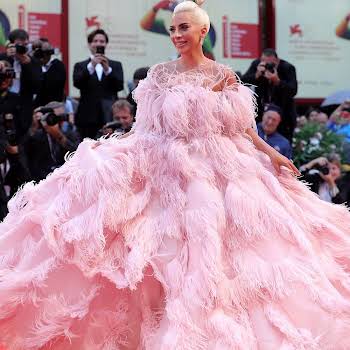
By IMAGE
16th Mar 2015
16th Mar 2015
Marco De Vincenzo
Imagine a day when you’ll fling your designer dress in the washing machine, use an app to buy clothes in a shop window, or wear a fibre optic dress. JO LINEHAN meets the designers and scientists at the forefront of fashion’s not-so-far-away future.
Giles Deacon is a futurist – but then again, anyone who loves fashion is. The industry is arguably one of the fastest moving alongside technology, obsessed with pushing the boundaries and testing the limits of what we wear and how we come to wear it. Take future-loving megabrand Burberry, for instance; pay a visit to their Regent Street store – the largest in the world – and you’ll find fitting rooms fixed with mirrors that transform into screens, allowing customers to watch how the piece was made and what it looks like in full-flow on the catwalk, while members of staff, all equipped with iPads, await, ready to help you find exactly what you’re looking for. On the high street, Jaeger’s Iconeme app connects to the retailer’s website, allowing window shoppers to purchase items on mannequins immediately, regardless of the time of day or whether the store is open. This year saw 3D technology print the first ever pair of shoes, and uring New York Fashion Week, Apple unveiled their Apple Watch, no doubt in hopes that fashion’s vanguards would give it their seal of approval. So where are the trends coming from, and what can we really expect next from the clothes we wear and the people who make them for us?

Fashion’s future, says Mary Katrantzou, lies firmly in fabrics. Her futuristic digital prints, trompe-l??il dresses and obscure silhouettes have delighted the catwalks of London Fashion Week since she debuted five years ago. ?When I first began designing, digital printing was so taboo and could only be done on natural fabrics – cotton and silk. The technology used at mills now is allowing us to create amazing fabric hybrids that have been the basis for our creative fantasies. My lampshade dress is a great example of the new developments – that shape could never have been created without these super-materials.?
Our appetite for these new shapes and multifaceted textures is all down to our fast-paced, tech-heavy lifestyles. Dubbed as the ‘multisensorial? trend, psychologists now know that the?rise in our interaction and use of technology has left us craving tactile experiences wherever we can get?them – especially when it comes to?our clothing. ?The future of fashion is?tactile and unexpected,? says Sabine?Le Chatelier of Premi’re Vision, the?world’s leading fabric tradeshow. ?It’s?no coincidence that we’re seeing an explosion in furry separates, bubble-effect surfaces, and more and more unusual feels to clothes. People want to be surprised when they go to touch a piece, so while a tunic might look like neoprene, it’s silk to touch.?
Giles Deacon is a man excitedly at the forefront of fashion development. His autumn/winter 2014 collection saw Jourdan Dunn and Malaika Firth debut high-end pieces that were machine- washable, and he’s worked with Ariel’s Fabric Care labs in Brussels, testing new fabrics and developing high-tech products to clean and care for the fibres of all types of fabrics in his clothes.
?I went back to my studio in Shoreditch to design a capsule collection with Ariel and Lenor.?As a designer, the idea of ensuring my designs’stay the way they are supposed to after washing is fascinating. But also, I have to admit, I’ve always been interested in science, and obviously in fabrics, so it seemed like a natural fit.? The result is a collection of eleven pieces, all exuding Deacon’s brilliant prints and playful aesthetic, all machine- washable without compromising on design.
?Realistically, dry cleaning isn’t a viable option for the future,? says Ariel’s FibreSCIENCE expert Neil Lant. ?It’s expensive and inconvenient. We’re creating a reality where you can chuck your Mary Katrantzou silk dress into the washing machine and have it come out looking just as bright and vibrant and fresh as the day you took it home.? It’s certainly an exciting idea, especially in terms of creating a pocket- and environmentally- kind future – so how soon can we experience it? ?The good news is our latest formulas actually enhance and rejuvenate your clothes with every wash, rather than deplete them. But silk is our biggest challenge right now. We’re working on it, and once we crack that, it’ll bring fashion and our everyday clothing to a whole other level.? The long-term love affair with our clothes is a vision reiterated by renowned fashion journalist and stylist Gianluca Longo: ?We are no longer obsessed with the cult of the dress of the season – we want to buy something and keep it, fall in love with it as long as we can. The future of fashion is in longevity.?
For online retailers, the challenge now is to help customers know what to expect from the clothes they are looking at on their smartphone or computer screen. Fujitsu recently launched a prototype tablet featuring haptic technology, giving users the illusion of being able to feel the texture of the pictures they see onscreen. For us as customers, a major drawback of shopping online is the fear of the unexpected – this could be the solution. The reality is that fashion’s future is already in motion; both Richard Nicoll and Marco de Vincenzo debuted futuristic pieces this season, Nicoll in the form of a fibre optic slip, inspired by Tinkerbell, and de Vincenzo with flashy, space-aged metallic coats and dresses in a durable, moveable fabric, fulfilling Katrantzou’s prophecy: ?the future of fashion goes beyond the aesthetic of the clothes – it integrates print and texture, and I think the future is experiential.? Clothes to wear and love forever? That’s ?a future that’s bright.
Follow Jo Linehan on Twitter @Jo_Linehan
This article originally appeared in the February issue of IMAGE. The March issue is on shelves now.
LOVE this? Why not have IMAGE delivered directly to your door each month? Check out this month’s offer here.























